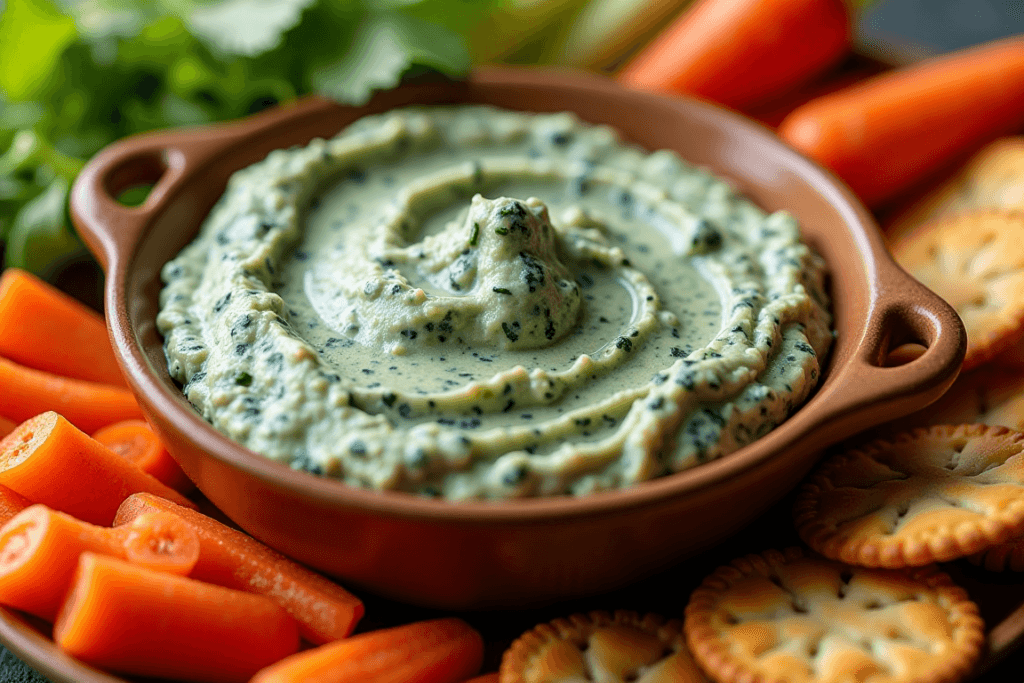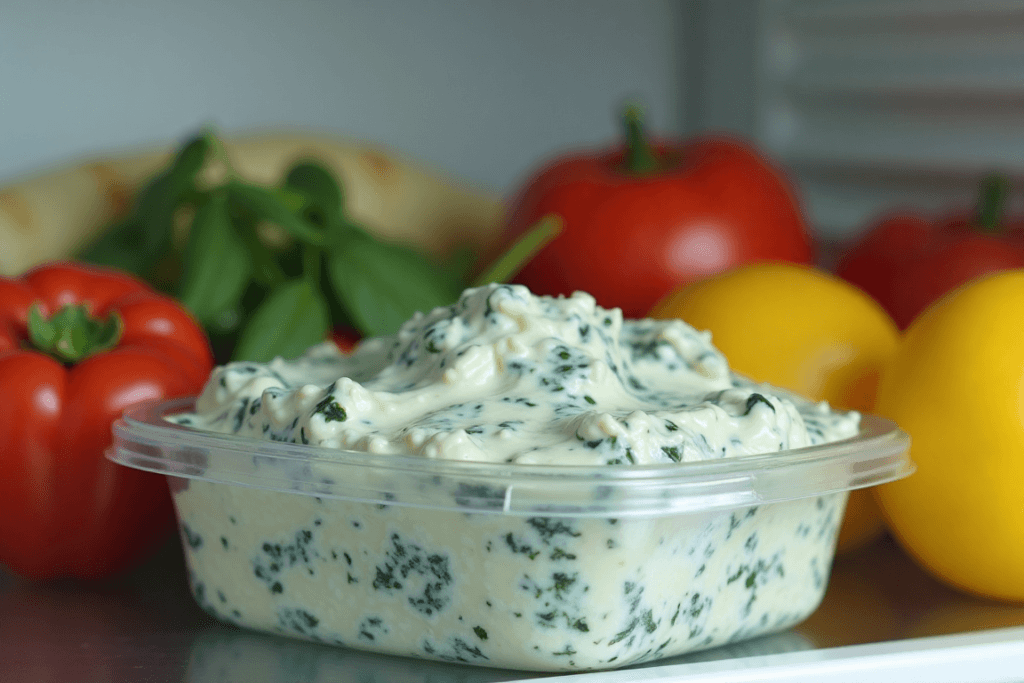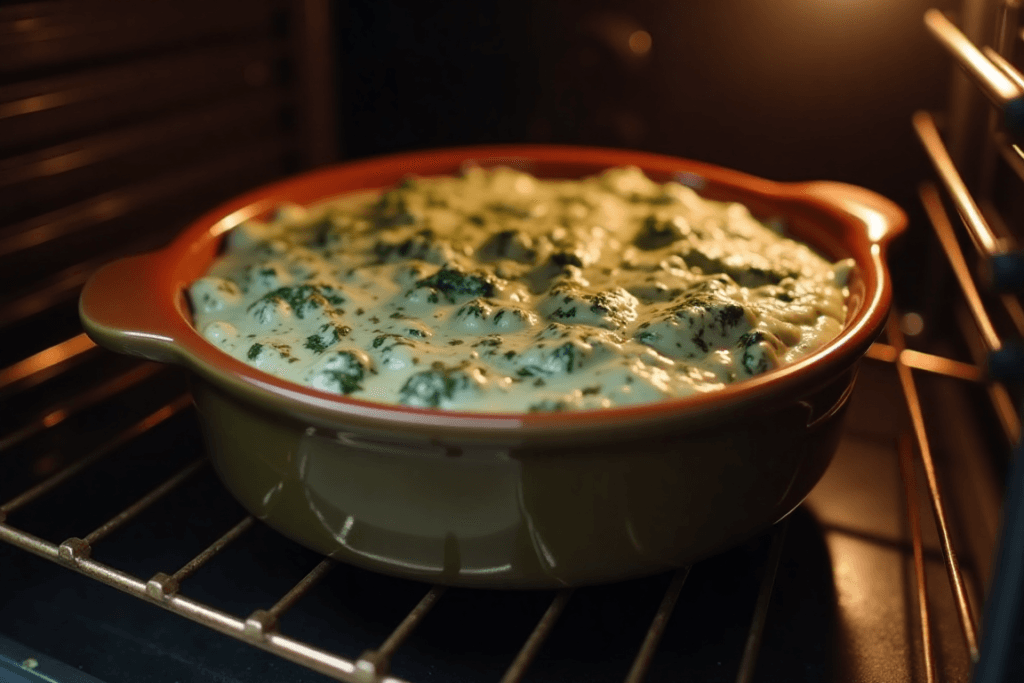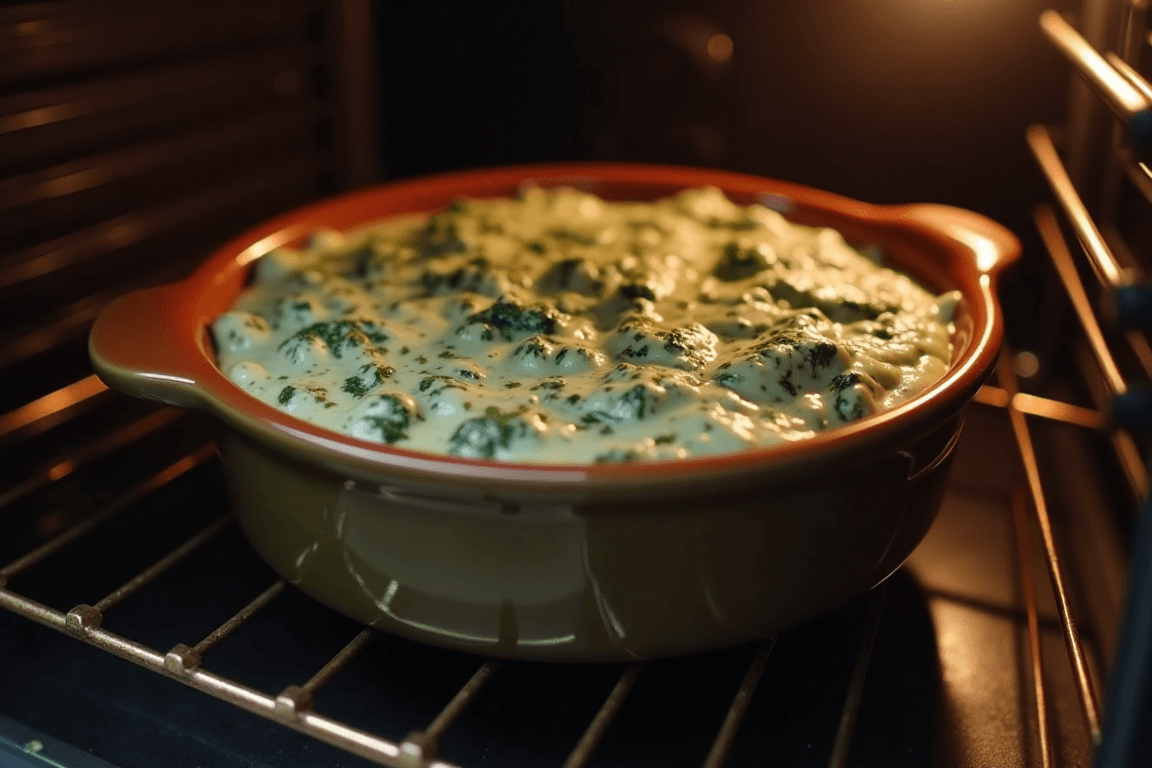Introduction
Spinach dip is a beloved appetizer enjoyed at parties, family gatherings, or as a simple snack. Its creamy texture and flavorful blend of spinach, cream cheese, and seasonings make it a popular choice. However, many people wonder, “Can I eat week-old spinach dip?” Like any perishable food, spinach dip raises questions about safety—especially when it’s been sitting in your refrigerator for a week.
This article addresses whether it’s safe to eat week-old spinach dip, explores the factors affecting its freshness, and offers tips on how to store and handle leftovers properly.

Understanding Spinach Dip
Spinach dip is a versatile dish, available in countless variations. It can be homemade or store-bought, served warm or cold, and paired with everything from crackers to fresh vegetables. Understanding its ingredients and preparation methods is key to determining how long it stays safe to eat.
Common Ingredients in Spinach Dip
Most spinach dips include ingredients such as:
- Spinach: Fresh or frozen, providing the signature flavor and texture.
- Dairy: Cream cheese, sour cream, mayonnaise, or yogurt are typical bases that contribute to its creamy consistency.
- Seasonings: Garlic, onion, and spices like dill or paprika add flavor.
- Add-ins: Some recipes feature cheeses (Parmesan, mozzarella), artichokes, or even bacon for variety.
Homemade vs. Store-Bought Spinach Dip
The type of spinach dip you’re dealing with influences its shelf life:
- Homemade Spinach Dip: Lacks preservatives, making it more perishable. Typically lasts 3–5 days when refrigerated.
- Store-Bought Spinach Dip: Includes preservatives that extend shelf life, often lasting 7–10 days in the refrigerator after opening. Always check the packaging for specific guidance.
Proper Storage Methods
How you store spinach dip significantly impacts its freshness. Consider these tips:
- Refrigeration: Always refrigerate spinach dip promptly after serving. Keep it in an airtight container to prevent contamination.
- Temperature Control: Do not leave spinach dip at room temperature for more than two hours. Bacteria thrive between 40°F and 140°F.
- Freezing: If you don’t plan to finish the dip within a few days, freezing is an option. However, dairy-based dips may change texture when thawed.
Food Safety Guidelines
Ensuring food safety is critical when dealing with perishable items like spinach dip. The USDA and FDA provide guidelines to help consumers determine whether leftover foods, including spinach dip, are still safe to eat.
General Rules for Refrigerated Leftovers
- Storage Time: Most cooked or prepared foods, including dips, should be consumed within 3–4 days if refrigerated. Week-old spinach dip exceeds this timeframe.
- Temperature Control: Keep your refrigerator at or below 40°F to slow bacterial growth.
- Container Type: Store the dip in a shallow, airtight container to ensure even cooling and to reduce exposure to air.
Signs of Spoilage in Spinach Dip
To assess if your spinach dip is still safe to eat, inspect it closely for these signs:
- Appearance: Look for mold, discoloration, or separation of liquids.
- Odor: Spoiled dip often develops a sour or unpleasant smell.
- Texture: If the dip feels slimy or grainy, it may no longer be safe.
- Taste: Avoid tasting spinach dip if any of the above signs are present. Even a small amount of spoiled food can cause illness.
Applying Food Safety to Spinach Dip
Spinach dip combines several perishable ingredients, such as dairy and vegetables, which are particularly susceptible to spoilage:
- Dairy Products: Cream cheese and sour cream can develop harmful bacteria like Listeria when stored improperly or for too long.
- Spinach: Fresh or cooked spinach can harbor bacteria such as E. coli if cross-contaminated or left unrefrigerated.
- Mayonnaise: Commonly used in cold dips, mayonnaise can spoil rapidly if left at room temperature.

Shelf Life of Spinach Dip
The shelf life of spinach dip depends on several factors, including whether it is homemade or store-bought, how it is stored, and the ingredients used. Let’s explore these aspects in more detail.
Factors That Influence Freshness
- Ingredients Used:
- Dairy Content: High-fat dairy products like cream cheese or sour cream can spoil quickly when exposed to air or improper temperatures.
- Fresh vs. Preserved Spinach: Fresh spinach is more prone to degradation compared to spinach preserved with freezing or blanching.
- Storage Conditions:
- Refrigerated Dips: Refrigeration slows bacterial growth, but it doesn’t eliminate it. Dips stored in tightly sealed containers last longer than those exposed to air.
- Room Temperature Exposure: Leaving spinach dip at room temperature for extended periods (over 2 hours) accelerates spoilage.
- Preservatives in Store-Bought Dips:
- Many store-bought spinach dips include stabilizers or preservatives, extending their shelf life to approximately 7–10 days after opening. However, this doesn’t guarantee safety after a week if storage conditions are poor.
Shelf Life Estimates
- Homemade Spinach Dip: Typically lasts 3–5 days when refrigerated properly. The absence of preservatives means it spoils faster.
- Store-Bought Spinach Dip: Unopened, it can last several weeks in the fridge, but once opened, it should be consumed within 7–10 days. Always check the expiration date on the packaging.
Importance of “Use-By” and “Best-By” Dates
When dealing with store-bought spinach dip:
- Use-By Dates: Indicates the last date for safe consumption. Consuming the dip after this date increases the risk of foodborne illnesses.
- Best-By Dates: Refers to peak freshness. The dip may still be safe shortly after this date if stored correctly, but its quality may decline.
When in Doubt, Throw It Out
If you’re uncertain about whether your spinach dip is safe to eat, it’s best to discard it. The potential risks of consuming spoiled food far outweigh the cost of making or buying a new batch.
Risks of Eating Week-Old Spinach Dip
Consuming spinach dip that has been stored for a week can pose several health risks. Understanding these risks will help you make informed decisions about food safety.
Foodborne Illnesses and Bacteria
Spinach dip contains perishable ingredients that are susceptible to bacterial growth if not stored properly or consumed promptly. Here are common pathogens associated with spoiled spinach dip:
- Listeria Monocytogenes:
- Found in dairy-based products, especially cream cheese and sour cream.
- Can cause serious illness, particularly in pregnant women, the elderly, and those with weakened immune systems.
- Salmonella:
- May contaminate spinach through improper handling or cross-contamination.
- Causes symptoms such as fever, diarrhea, and abdominal pain.
- Escherichia coli (E. coli):
- A risk with raw or improperly washed spinach.
- Leads to severe stomach cramps, vomiting, and, in rare cases, kidney failure.
Symptoms of Food Poisoning
If you consume week-old spinach dip that has spoiled, you may experience symptoms of food poisoning, including:
- Nausea and vomiting.
- Diarrhea, which may be watery or bloody.
- Stomach cramps and abdominal pain.
- Fever or chills.
- Fatigue or weakness.
Health Risks from Mold
Visible mold on spinach dip is a clear sign of spoilage. Consuming even small amounts of moldy dip can cause adverse reactions:
- Mycotoxins: Toxins produced by mold can lead to digestive upset and, in severe cases, liver damage.
- Allergic Reactions: Mold exposure may trigger allergic reactions in sensitive individuals, causing respiratory symptoms or skin irritation.
Who Is Most at Risk?
Certain groups are more vulnerable to foodborne illnesses and should be particularly cautious about consuming older spinach dip:
- Pregnant Women: Risk of complications from Listeria infections.
- Young Children: Developing immune systems are less capable of fighting off pathogens.
- Elderly Adults: Weakened immune systems make it harder to recover from foodborne illnesses.
- Immunocompromised Individuals: Those with chronic illnesses or undergoing treatments like chemotherapy are at higher risk.
Long-Term Impacts of Foodborne Illness
In most cases, food poisoning resolves within a few days. However, severe cases can lead to long-term complications:
- Kidney Damage: Particularly in cases of E. coli infection.
- Chronic Digestive Issues: Some individuals develop irritable bowel syndrome (IBS) after severe food poisoning.
- Hospitalization: In extreme cases, foodborne illnesses can require medical intervention.
For more details on leaving spinach dip at room temperature, check out Can You Eat Spinach Dip Left Out Overnight?.
How to Safely Consume Leftovers
To minimize food waste and reduce the risks of foodborne illnesses, it’s important to handle spinach dip leftovers with care. Follow these tips to safely consume your dip while maximizing its freshness.

Best Practices for Storage
- Refrigerate Immediately:
- After serving spinach dip, refrigerate leftovers within two hours.
- For outdoor events, reduce the time to one hour if the temperature exceeds 90°F.
- Use Airtight Containers:
- Store spinach dip in sealed, shallow containers to prevent air exposure and contamination.
- Label containers with the date to keep track of how long the dip has been stored.
- Avoid Cross-Contamination:
- Always use clean utensils when serving or transferring dip.
- Avoid double-dipping to limit the spread of bacteria.
Proper Reheating Methods
If your spinach dip is intended to be served warm, reheating can improve its taste and texture while ensuring it’s safe to eat.
- Microwave Method: Transfer the dip to a microwave-safe dish and heat in 30-second intervals, stirring in between, until it reaches an internal temperature of 165°F.
- Oven Method: Reheat in an oven-safe dish at 350°F for about 10–15 minutes or until heated through.
How to Tell If It’s Safe to Eat
Before consuming leftover spinach dip, inspect it for signs of spoilage:
- Visual Check: Look for any discoloration, mold, or liquid separation.
- Smell Test: Discard the dip if it has a sour, rancid, or otherwise unpleasant odor.
- Texture Check: If the dip feels slimy or grainy, it’s no longer fresh.
Tips for Maximizing Shelf Life
- Portion Before Serving:
- Serve smaller portions of spinach dip to reduce the amount exposed to room temperature.
- Keep the rest refrigerated and replenish as needed.
- Use Ice Packs for Outdoor Events:
- Place the serving dish over a tray of ice to maintain a cooler temperature.
- Consider Freezing:
- If you don’t plan to finish the dip within a few days, freezing is an option.
- Portion the dip into smaller, freezer-safe containers, leaving room for expansion.
- Use frozen spinach dip within 1–2 months for the best quality.
Safe Thawing and Reuse
Frozen spinach dip should be thawed properly before consumption:
- Refrigerator Thawing: Place the container in the refrigerator overnight.
- Avoid Counter Thawing: Never thaw spinach dip at room temperature, as it encourages bacterial growth.
Once thawed, use the dip immediately and do not refreeze.
Alternatives to Discarding Spinach Dip
If your spinach dip is nearing the end of its shelf life but still appears fresh, there are creative ways to repurpose it rather than throwing it away. Incorporating it into recipes not only prevents waste but also enhances the flavors of your meals.
Cooking with Spinach Dip
- Stuffed Chicken or Fish:
- Use spinach dip as a flavorful stuffing for chicken breasts or fish fillets.
- Simply spread the dip inside a butterflied chicken breast or a fillet, roll it up, and bake at 375°F until cooked through.
- Pasta Sauce:
- Transform spinach dip into a creamy pasta sauce.
- Heat it in a saucepan, add milk or broth to thin it out, and toss with cooked pasta.
- Vegetable Casserole:
- Use spinach dip as a layer in casseroles, such as a baked zucchini or broccoli dish.
- Spread it over the vegetables, sprinkle with cheese, and bake until bubbly.
Baking Ideas
- Spinach Dip Bread Bowl:
- Bake leftover dip in a hollowed-out bread bowl for an easy appetizer.
- Place the filled bread on a baking sheet, wrap in foil, and heat in the oven at 350°F until warm.
- Savory Muffins:
- Mix spinach dip into a muffin batter with a sprinkle of cheese for savory breakfast muffins.
- Pizza Topping:
- Spread spinach dip as a base sauce on homemade pizza dough.
- Add toppings like shredded mozzarella, mushrooms, or grilled chicken for a unique pizza flavor.
Freezing Spinach Dip for Future Use
If you’re not ready to consume the dip immediately, freezing is a great option. To freeze spinach dip successfully:
- Prepare for Freezing:
- Portion the dip into small, freezer-safe containers or resealable freezer bags.
- Remove as much air as possible to prevent freezer burn.
- Label and Date:
- Clearly mark the container with the date to track how long it has been frozen.
- Usage Ideas for Thawed Dip:
- Thawed spinach dip may lose some of its original texture but works well in cooked dishes like casseroles or baked pasta.
Creative Pairings with Spinach Dip
- Sandwich Spread:
- Use leftover spinach dip as a spread for sandwiches or wraps.
- Omelet Filling:
- Incorporate spinach dip into an omelet for a creamy, flavorful filling.
- Soup Thickener:
- Stir a small amount of spinach dip into soups for added creaminess and flavor.
Repurposing spinach dip not only reduces waste but also provides an opportunity to elevate your cooking with its rich and savory flavors.
Read more about ingredient swaps in Can I Substitute Canned Spinach for Fresh Spinach? and learn about the nutritional benefits in Is Frozen Spinach Healthy?.
Frequently Asked Questions (FAQs)
How long can spinach dip be safely stored in the refrigerator?
Spinach dip can typically be stored in the refrigerator for 3–5 days if homemade and 7–10 days if store-bought, provided it is refrigerated immediately after use and kept in an airtight container. Always inspect it for signs of spoilage before consuming.
Can you freeze spinach dip to extend its shelf life?
Yes, spinach dip can be frozen to extend its shelf life, especially if you don’t plan to eat it within a few days. Use freezer-safe containers or bags, label them with the date, and consume within 1–2 months for best quality. Note that dairy-based dips may change in texture when thawed.
What are the signs that spinach dip has gone bad?
Spoiled spinach dip may exhibit visible mold, discoloration, separation of liquid, a sour or unpleasant smell, or a slimy texture. If you notice any of these signs, discard the dip immediately.
Can reheating spoiled spinach dip make it safe to eat?
No, reheating cannot make spoiled spinach dip safe to eat. Bacteria can produce toxins that are heat-resistant, so consuming spoiled food poses a health risk even if it is reheated.
Is it safe to eat spinach dip that was left out overnight?
No, spinach dip left out overnight is not safe to eat. Perishable foods left at room temperature for more than two hours fall within the “danger zone” (40°F–140°F) where bacteria can multiply rapidly. Discard any dip that was left out for an extended period.
Are there any ingredients in spinach dip that spoil faster than others?
Yes, the dairy components in spinach dip, such as cream cheese, sour cream, and mayonnaise, spoil quickly if not stored properly. Fresh spinach can also deteriorate rapidly. These ingredients are why spinach dip has a limited shelf life and must be handled with care.
Conclusion
Spinach dip is a delicious and versatile dish, but it requires proper storage and handling to ensure it remains safe to eat. While store-bought spinach dip may last up to a week in the refrigerator, homemade versions are best consumed within 3–5 days. Always check for signs of spoilage, such as discoloration, off smells, or changes in texture, and remember that reheating cannot make spoiled food safe to eat.
To reduce waste, consider repurposing spinach dip in recipes like casseroles, stuffed chicken, or pasta sauces. If you don’t plan to consume it right away, freezing is a practical option to extend its shelf life. However, frozen dip is best used in cooked dishes to maintain its quality.
Ultimately, the safety of week-old spinach dip depends on how it was stored and handled. When in doubt, it’s better to err on the side of caution and discard it. By following food safety guidelines, you can enjoy spinach dip responsibly and avoid potential health risks.

